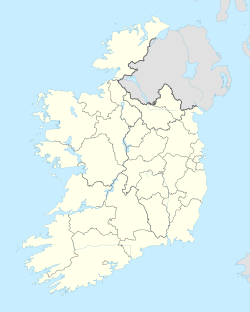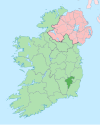world.wikisort.org - Ireland
Bagenalstown (/ˈbæɡnəlztaʊn/ BAG-nəlz-town), officially named Muine Bheag[2] (Irish: [ˌmˠɪnʲə ˈvʲaɡ]), is a small town on the River Barrow in County Carlow, Ireland.
Bagenalstown
Muine Bheag | |
|---|---|
Town | |
 The railway station | |
 Coat of arms | |
| Motto(s): Uimhir gan choisc "The Irrepressible Number" | |
 Bagenalstown Location in Ireland | |
| Coordinates: 52.701°N 6.957°W | |
| Country | Ireland |
| Province | Leinster |
| County | County Carlow |
| Elevation | 40 m (130 ft) |
| Population (2016)[1] | 2,837 |
| Time zone | UTC±0 (WET) |
| • Summer (DST) | UTC+1 (IST) |
| Eircode routing key | R21 |
| Telephone area code | +353(0)59 |
| Irish Grid Reference | S683609 |
History and name

The town grew within the townland of Moneybeg, from Irish Muine Bheag or Muinebheag (meaning "small thicket").[3] In the 18th century there was a small hamlet there. Walter Bagenal decided to build a town on the site, to be named "New Versailles" and modelled after Versailles in France.[4][5] However, shortly after building began, the coach route from Dublin, which had passed the location, was changed so it crossed the River Barrow a few kilometres away, at Leighlinbridge, instead.[4] Bagenal abandoned his plans, having built only a courthouse.[4] It was not until the arrival of the railway in 1846 that the settlement began to grow into a town.[4]
In 1911 the town became the first in Ireland to install dual-language street signs, which remain in place today.[6] Following the creation of the Irish Free State in 1922, the town commissioners chose to drop the English name "Bagenalstown" in favour of the Irish Muine Bheag. Several other places in Ireland were re-named around this time. The decision proved an ineffective one, and "Bagenalstown" remained in common use among locals. In a 1975 plebiscite, 77% of residents who voted opted to change the name back, but the proposal failed due to voter turnout of only around 50%, while the law required 75%.[6]
The motto on the town's coat of arms is "The Irrepressible Number" and its Irish equivalent Uimhir Gan Choisc.
Historic industry and town function
Bagenalstown's history is strongly associated with the milling industry. Rudkins' Mill marked the start of this industry. It was erected by Henry Rudkins between the end of the 17th century and the start of the 18th century.[7] Shortly after the opening of Rudkins' mill another mill was opened by Owen Murphy; this would be more commonly known as Lodge Mills.[8]

In 1792 the Barrow Navigation Company began their plan to link the town and river to the Grand Canal. The construction of the canal allowed boats of up to 40 tonnes to transport goods directly to Dublin. In 1845, record numbers were recorded as 111,225 passengers and 286,601 tonnes of goods were transported along this route. Many of the boats that were used for transporting goods on this canal were owned by corn buyers and maltsters. This allowed them to efficiently transport the goods they needed direct from the Rudkins' Mill and Lodge Mill.[8]
Bagenalstown very quickly transitioned into a highly prosperous town, and became recognised as a post, boat, mill and marketplace hub. The tradition of milling was also joined by salt and gas works in the 18th and 19th centuries. The canal route very quickly declined once the railway had been introduced and in 1852, only a small number of trading boats remained on this river. As of 2018, the canal is only used as a tourist attractions.[8]
Transport
The town is on the River Barrow. It is at the junction of the R705 and R724 regional roads and lies on the eastern side of the R448.
It is connected to the railway network on the Dublin – Kilkenny section of the Dublin-Waterford railway line. This connects the town to nearby Carlow, as well as Kilkenny to the southwest. The station opened on 24 July 1848 as Bagnalstown and was renamed Bagenalstown by April 1910. It was permanently closed to passengers on 30 March 1963 and for goods traffic on 6 September 1976.[9] The station was reopened and officially renamed "Muine Bheag" in 1988 although Bagenalstown is recognised as its common name on the bilingual nameboards, in place since 2015, and on the Iarnród Éireann website.[10]
Places of interest

Near Bagenalstown is Ballyloughan Castle, which comprises a twin-towered gatehouse and the hall and foundations of one of the corner towers of a large castle dating from about 1300.[11]
Ballymoon Castle is 3 km (2 mi) east of Bagenalstown, and is thought to date from the 13th century.[12]
Community groups
The 1st Bagenalstown BP Scout Group was set up in 2009 and meets in the McGrath hall. Their activities include hiking, camping, kayaking and games.[13]
Bagenalstown hosts a floral festival every August.
Sport
Muine Bheag is the local GAA club, formed in 2018 after the amalgamation of three former clubs. Bagenalstown has had a long tradition in cricket. The Bagenalstown Cricket Club was first formed in 1843 by the local millers, and is still in use. The club's logo is a grinding wheel, which was used in early milling.
There is an outdoor, river-side, swimming pool on the approach road to the town from Leighlinbridge.
The racehorse Danoli, described in 1995 as "the most popular racehorse in Ireland"[14] was trained near the town by Thomas Foley.
Education
Bagenalstown has three primary schools and two secondary schools:
- Queen of the Universe National School, founded by Bishop Keogh in 1957, is a primary school for boys (junior infants to 1st class) and girls.
- St Brigid's National School, founded in 1865, is a primary school for boys only from classes 2nd to 6th.
- St Mary's National School is a co-educational school under Church of Ireland patronage.
- Presentation De La Salle College is a secondary school, established in 1983. This Catholic College is under the trusteeship of the De La Salle Brothers, the Presentation Sisters and Bagenalstown Parish.
- Muine Bheag Vocational School is a secondary school, opened in 1963.
International relations
The town was twinned with the town of Pont-Péan, Brittany in 1999. The twinning charter, which is written in Irish, English and French, commits the two towns to "developing social, economic, cultural, touristic, and sporting links" between the two communities.
Notable people
- Beauchamp Bagenal (1741–1802), rake, duellist and reputedly "the handsomest man in Europe"[15]
- Seán Drea, World Rowing Championship silver medalist, Olympian and world record-breaking sculler
- Richie Kavanagh, entertainer
- John Lucas, soldier who won a Victoria Cross during the Taranaki Maori War in New Zealand in 1861
- Martin O'Neill, first Irish man to win the British competition One Man and His Dog[16]
See also
- List of towns and villages in Ireland
References
- "Sapmap Area - Settlements - Muinebeag (Bagenalstown)". Census 2016. Central Statistics Office Ireland. April 2016. Retrieved 26 December 2019.
- "Muine Bheag". Placenames Database of Ireland. Retrieved 18 April 2014.
- "Why rail is the way to go | Munster Express Online". Munster-express.ie. 14 March 2008. Retrieved 21 July 2012.
- Mayse, Shirley. Our Caswell Relatives. University of Wisconsin, 1975. p.343
- Darley, Gillian (1975). Villages of vision. London: Architectural Press. pp. 103, 148. ISBN 0-85139-705-0. OCLC 1921555.
- "Carloviana" (PDF). Carlow Historical and Archaeological Society. 2004. p. 10.
- Feeley, J.M. "Rudkin's Mill. Bagenalstown" (PDF). glasnost.itcarlow. Retrieved 2 December 2021.
{{cite web}}: CS1 maint: url-status (link) - Carloviana. Carlow: Carlow Historical and Archaeological Society. 2018. pp. 18–29.
- "Bagenalstown station" (PDF). Railscot – Irish Railways. Retrieved 11 October 2008.
- "Muine Bheag (Bagenalstown)". Iarnród Éireann. Retrieved 26 August 2022.
- "Ballyloughan Castle". Carlow Tourism – Castles. Archived from the original on 11 March 2005. Retrieved 9 December 2007.
- "Ballymoon Castle, County Carlow". Irelands Eye.com. Retrieved 10 December 2007.
- "Tuesday, March 29, 2011. Bagenalstown Parish, Co Carlow. Diocese of Kildare and Leighlin".
- Mallon, Brian (11 April 1995). "Danoli's career still in balance after operation". The Independent. Retrieved 21 July 2012.
- Donaldson, William Rogues, Villains and Eccentrics: An A-Z of Roguish Britons Through the Ages pp 38–9, Phoenix, London, 2002
- "Sheepdog Trials". RTÉ.ie.
External links
На других языках
[de] Muine Bheag
Muine Bheag [.mw-parser-output .IPA a{text-decoration:none}ˈmˠɪnʲə vʲɔɡ] („Kleines Dickicht“)[2] ist eine Kleinstadt im Südosten der Republik Irland im County Carlow. Bei der Volkszählung 2016 hatte sie 2749 Einwohner.[1]- [en] Bagenalstown
[ru] Мине-Бег
Мине-Бег[2] (Муим-Баг; англ. Muine Bheag (Мыне-Вяг), также Bagenalstown, Muinebeag, Moneybeg[3]; ирл. Muine Bheag, «маленькая чаща»[4]) — (малый) город в Ирландии, находится в графстве Карлоу (провинция Ленстер).Другой контент может иметь иную лицензию. Перед использованием материалов сайта WikiSort.org внимательно изучите правила лицензирования конкретных элементов наполнения сайта.
WikiSort.org - проект по пересортировке и дополнению контента Википедии
